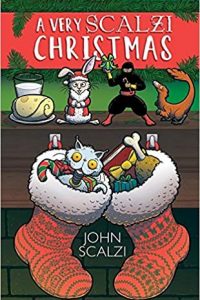Alex Brown Reviews Tim Te Maro and the Subterranean Heartsick Blues by H.S. Valley
 Tim Te Maro and the Subterranean Heartsick Blues, H.S. Valley (Hardie Grant 978-1-76058-75-3, $12.99. 320pp, tp) February 2023.
Tim Te Maro and the Subterranean Heartsick Blues, H.S. Valley (Hardie Grant 978-1-76058-75-3, $12.99. 320pp, tp) February 2023.
I first heard about New Zealand writer H.S. Valley’s debut 2021 novel Tim Te Maro and the Subterranean Heartsick Blues a little over year ago, and was instantly disappointed that I couldn’t acquire it through a US publisher. When I got a notification that review copies were available in the States, I had to have it. Reader, I’m thrilled to tell you that it was everything I’d hoped for.
Tim Te Maro just got dumped. Not only that, his ex-girlfriend left him for an obnoxious, dull dudebro. With the prospect of spending the rest of his time at Fox Glacier High School for the Magically Adept on the South Island of New Zealand alone, Tim is understandably anxious and upset. That’s when Elliott, a white boy who was dumped by said dudebro for Tim’s ex, proposes a solution: get paired up for a school project and make their exes jealous. It works. The boys are grouped together to ‘‘raise’’ a magic egg baby for a Home Ec-like class. Soon, however, things slide from flirting to desire to something deeper.
Elliott and Tim can’t keep their hands off each other. Once the project is done, they’ll cut things off, no harm, no foul, no strings attached. That was the plan, right? But the more time they spend together, and the more nighttime fun they have, the more the walls they built to keep each other out begin to crumble. When a drunken spell goes awry, the boys face some very big decisions. More slice-of-life than plot-heavy, Tim Te Maro and the Subterranean Heartsick Blues meanders through the story. It’s a cozy, intimate novel about love, life, and teenage impulses.
H.S. Valley, who, like Tim, is also biracial white and Māori and was raised largely by her white relatives, does a fantastic job of rooting the story in Māori culture and Aotearoa history. Readers unfamiliar with Māori culture or New Zealand life might struggle a bit to figure out what’s going on, but I think it’s a good kind of struggle. Valley doesn’t waste time explaining basic concepts or translating for non-Māori speakers. Why should she? Tim and his friends already know what the words mean. My ignorance is my own to contend with. Most of it makes sense with context clues, and the rest I looked up. She keeps the story centered on Tim’s experiences.
Magic here is influenced as much by ancestry and heritage as it is by intent and skill. Magic is done with the assistance of mea, a Māori word Valley applies to the objects used to channel their powers and represent their intentions; for example, the pounamu necklace given to Tim by his father, a man built ‘‘like a brick shithouse,’’ gives temporarily enhanced strength. Overall, however, the magic system Valley has created is both very interesting and also not nearly enough. Valley offers lots of intriguing facts and ideas, but hastily stitches them together.
I have no idea how New Zealand/Pacific Island magic compares or contrasts to the rest of the world. How common are magic schools? How have they managed to keep humans in the dark all this time? Magic seems fairly limited in terms of power – there are no godlike magicians trying to conquer the world – but it also seems powerful enough that it should’ve changed the course of history at least somewhat, but Valley gives us almost nothing about the world beyond the school and the nearest town. Readers don’t need to know everything, but we needed more than what we were offered.
The adults in the story are also poorly sketched. They serve as plot devices rather than being actual people, particularly Tim’s parents. They appear only when Valley needs them to solve a problem or push Tim and Elliott into a new scenario. YA fantasy tends to view parents as obstacles to overcome or nonentities who either died or abandoned their charges. Occasionally we get a book where the parents are present and kind to the protagonist, but rarely do we get parents who are actively involved in the plot. Valley missed a good opportunity for the latter here.
That said, the character development we do get – of the rest of the friend group and especially Tim and Elliott – is where this story really shines. Valley is very good at writing 21st century teenagers. The ebbs and flows of relationships, the chaos of breakups, the hyperbole of language, the way everything seems simultaneously impossibly far away yet everywhere all at once, the hugeness of their feelings, it was all so vivid and tangible.
It also has several of my favorite romance tropes: enemies-to-lovers, secret relationship, friends with benefits, and ‘‘there was only one bed!’’ We need more young adult fiction that talks openly and honestly about sex, boundaries, and healthy relationships, and this book has that in spades. The teens are all having (offscreen) sex, but safely and with consent front and center. Anxiety and the fallout of a child being abandoned by a parent are depicted realistically. We can see how Tim jumps into relationships as a way to fill the void left by his father, and the emotional and psychological consequences of that destructive behavior. Tim and Elliott’s relationship was handled so well. Their physical intimacy never becomes a spectacle or titillation for the reader. Valley knows what to depict and when to fade to black.
Tim Te Maro and the Subterranean Heartsick Blues’s charms far outweigh its flaws. Reading this novel was a joyful experience. It made me happy just thinking about it. It is a lovely, warm young adult contemporary fantasy that makes me yearn to read more from H.S. Valley. I hope she has more books in the publishing pipeline, because this was a fantastic debut. Whether we get to explore more of this fascinating world or get something entirely new, as long as I get more Valley I’ll be happy.
Alex Brown is a librarian, author, historian, and Hugo-nominated and Ignyte award-winning critic who writes about speculative fiction, young adult fiction, librarianship, and Black history.
This review and more like it in the April 2023 issue of Locus.
 While you are here, please take a moment to support Locus with a one-time or recurring donation. We rely on reader donations to keep the magazine and site going, and would like to keep the site paywall free, but WE NEED YOUR FINANCIAL SUPPORT to continue quality coverage of the science fiction and fantasy field.
While you are here, please take a moment to support Locus with a one-time or recurring donation. We rely on reader donations to keep the magazine and site going, and would like to keep the site paywall free, but WE NEED YOUR FINANCIAL SUPPORT to continue quality coverage of the science fiction and fantasy field.
©Locus Magazine. Copyrighted material may not be republished without permission of LSFF.








